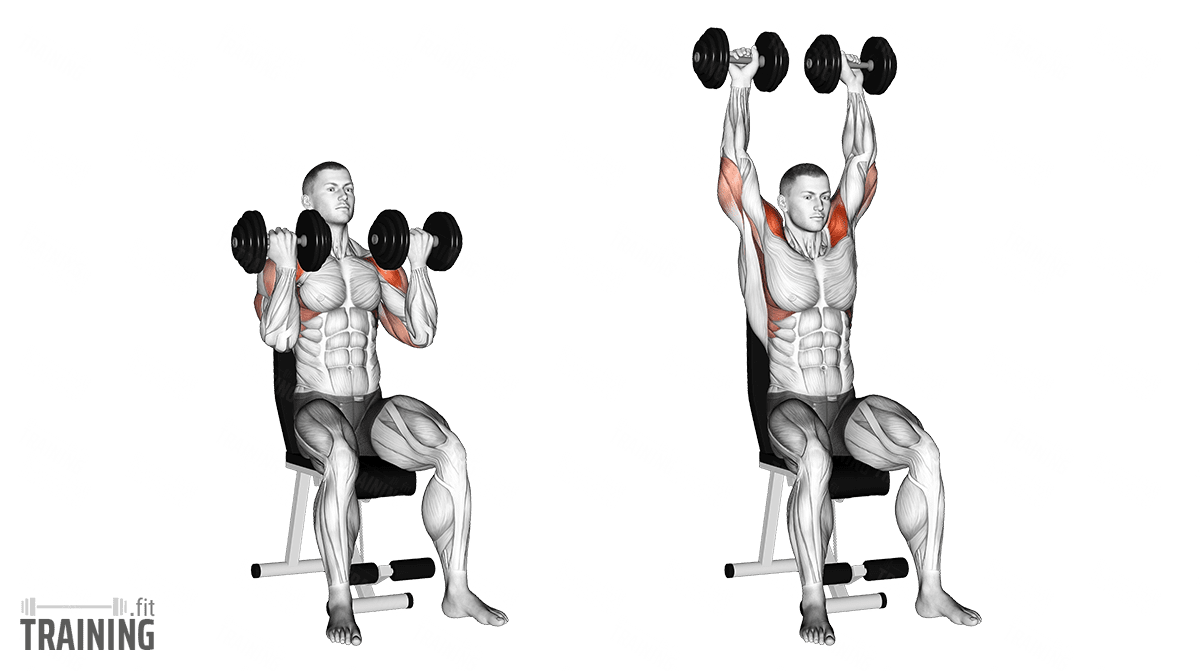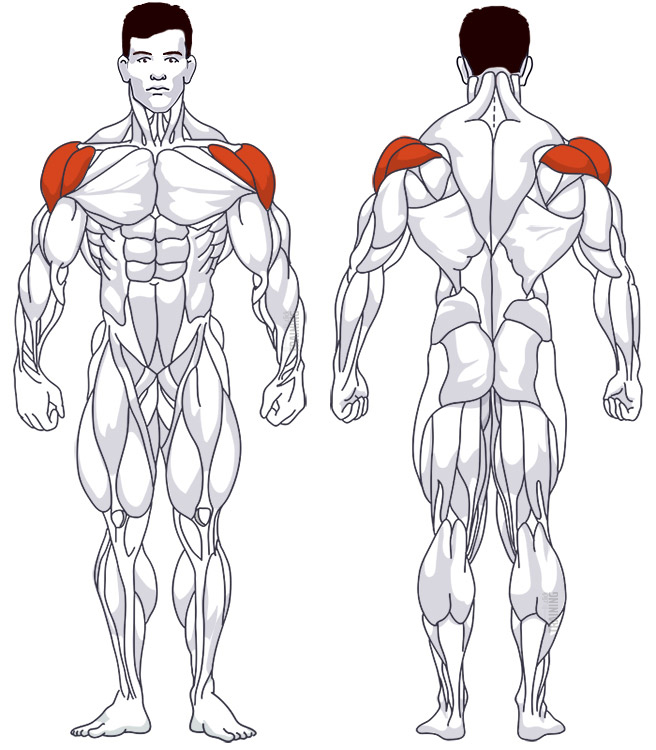Arnold Press
Isolation exercise, Free weightsThis article is verified by 1 study/publication.
Overview

Main muscles
- Shoulder: Anterior deltoid muscle
(Musculus deltoideus, Pars clavicularis)
Arnold Press: Basics and alternatives

Involved main muscle groups:
Arnold Press
The Arnold Press is a unique variation of the dumbbell shoulder press. It involves pressing dumbbells overhead with both arms from shoulder or neck height in a twisting motion. Just like Arnold dips, this was a favorite exercise of Arnold Schwarzenegger.
The difference between the normal shoulder press and the Arnold Press lies in the movement sequence. As you move the dumbbells up and down, you rotate them. At the beginning of the movement, your palms face inwards, and at the end, they face outwards.
This change in load during the exercise activates all three parts of the deltoid muscle more. A 2017 study showed that the activation of the shoulder is greater with the Arnold Press than with the normal dumbbell shoulder press.[1]
Correct Execution
The Arnold Press can be done standing, on a flat or incline bench, or seated on the floor. In any case, the exercise is done through the rotation necessary with dumbbells and in contrast to the normal shoulder press with a barbell option.
Video Tutorial
Step-by-Step Instructions
Set the back of the incline bench as steep as possible.
Sit on the bench and place the dumbbells on your knees. Your back presses against the backrest and your feet are firmly on the floor, so you have a stable sitting position. You should form a slight hollow back to relieve stress from the back.
Now lift the dumbbells in front of your torso. This works easier if you lift one knee at a time to get one dumbbell into position with momentum. This swinging motion is usually only necessary as your workout progresses when the weights become significantly heavier. To start, it’s best to choose a weight that you can get up without using your knees.
The dumbbells are now in front of your torso with your palms facing you.
Now push the weight up and extend your arms. As you do this, rotate your forearms 180 degrees. At the end of the movement, your palms face forward.
Do not fully extend your elbows, but keep them slightly bent (see chapter “Common Mistakes”).
Once at the top, return the dumbbells to the starting position in front of your torso (point 4). At the end of the movement, your palms face you again.
Alternative Execution
As mentioned earlier, you can perform the Arnold Press without an incline bench. It’s also possible to do the exercise standing or sitting on the floor. However, you’ll need to stabilize your upper body more, and the posture of your back is even more critical than on the incline bench. This makes the execution more challenging, so it’s mainly recommended for experienced athletes.
Common Mistakes
At the end of the extension movement, don’t fully extend your arms. Keep your elbows slightly bent so that the load is constantly on your muscles (not your joints) and to maintain the tension.
The complete extension of the arms and the sudden loss of muscle tension can, in the worst case, cause one arm to buckle and the dumbbell to fall on your head.
Sources
- Comparison among the EMG Activity of the Anterior Deltoid and Medial Deltoid During Two Variations of Dumbbell Shoulder Press Exercise. Shiny Raizada, Amritashish Bagchi. Indian Journal of Public Health Research and Development 8(4):653. doi: 10.5958/0976-5506.2017.00411.9. URL: https://www.researchgate.net/publication/322132613_Comparison_among_the_EMG_Activity_of_the_Anterior_Deltoid_and_Medial_Deltoid_During_Two_Variations_of_Dumbbell_Shoulder_Press_Exercise, retrieved 2020-08-25